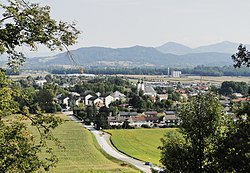Ebenthal in Kärnten (Slovene: Žrelec) is a town in the district of Klagenfurt-Land in the Austrian state of Carinthia.
Ebenthal in Kärnten | |
|---|---|
 Ebenthal | |
| Coordinates: 46°36′34″N 14°21′20″E / 46.60944°N 14.35556°E | |
| Country | Austria |
| State | Carinthia |
| District | Klagenfurt-Land |
| Government | |
| • Mayor | Franz Felsberger (SPÖ) |
| Area | |
| • Total | 54.98 km2 (21.23 sq mi) |
| Elevation | 415−855 m (−2,390 ft) |
| Population (2018-01-01)[2] | |
| • Total | 7,851 |
| • Density | 140/km2 (370/sq mi) |
| Time zone | UTC+1 (CET) |
| • Summer (DST) | UTC+2 (CEST) |
| Postal code | 9065 |
| Area code | 0463 |
| Vehicle registration | KL |
| Website | www.ebenthal.co.at |
Geography
editEbenthal lies southeast of Klagenfurt. The Sattnitz Mountains stretch east and west and are a popular goal for outings. The Glan and the Gurk flow through the municipality and into the nearby Wörther Lake. The Glanfurt flows into the Glan near the middle of the municipality. The Radsberg forms the southern boundary of the municipality.
The nature reserve Höflein-Moor is in the municipality.
Population
editAccording to the 2001 census 4.2% of the population are Carinthian Slovenes.
| Village | Number of people 1991 | Percent of Slovenes 1991 | Percent of Slovenes 1951 |
|---|---|---|---|
| Kossiach/Kozje | 60 | 31.7% | 21.3% |
| Kreuth/Rute | 93 | 72.0% | 86.7% |
| Lipizach/Lipica | 54 | 33.3% | 3.1% |
| Radsberg/Radiše | 88 | 75.0% | 100% |
| Schwarz/Dvorec | 143 | 12.6% | 29.4% |
| Tutzach/Tuce | 134 | 31.3% | 69.4% |
| Werouzach/Verovce | 35 | 60.0% | 100% |
| Kosasmojach/Kozasmoje | 35 | 0% | 95.0% |
| Moosberg/Kajže | 14 | 35.7% | 75.0% |
| Berg/Rute pri Medgorjah | 91 | 17.6% | 76.9% |
| Mieger/Medgorje | 2 | 0% | 33.3% |
| Hinterberg/Zagorje | 10 | 0% | 35.7% |
| Sabuatach/Zablate | 21 | 0% | 96.2% |
| Kohldorf/Vogle | 85 | 0% | 95.7% |
| Obermieger/Zg. Medgorje | 94 | 2.2% | 87.7% |
| Obitschach/Običe | 139 | 1.4% | 91.3% |
| Haber/Gaber | 38 | 0% | 92.4% |
| Rottenstein/Podgrad | 148 | 8.8% | 91.3% |
| Saager/Zagorje | 20 | 0% | 89.3% |
References
edit- ^ "Dauersiedlungsraum der Gemeinden Politischen Bezirke und Bundesländer - Gebietsstand 1.1.2018". Statistics Austria. Retrieved 10 March 2019.
- ^ "Einwohnerzahl 1.1.2018 nach Gemeinden mit Status, Gebietsstand 1.1.2018". Statistics Austria. Retrieved 9 March 2019.

